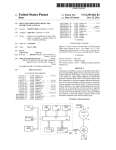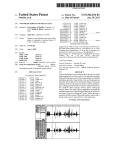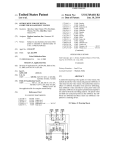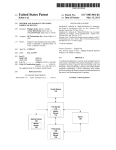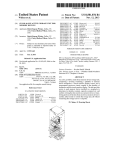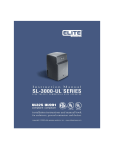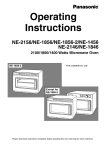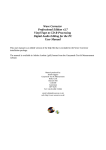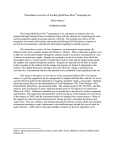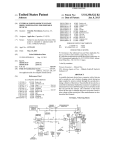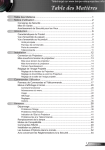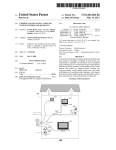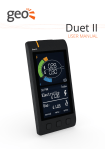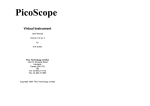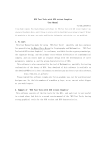Download Stretching/shrinking selected portions of a signal
Transcript
US008538761B1 (12) United States Patent Moulios et a1. (54) STRETCHING/SHRINKING SELECTED PORTIONS OF A SIGNAL 6,337,947 B1 * 7,055,166 7,424,677 7,454,010 7,702,014 (75) Inventors: Christopher J. Moulios, Cupertino, CA Notice: B1 B2 B1 B1 (US); Nikhil M. Bhatt, Cupertino, CA 2002/0028060 A1* (Us) 2002/0188602 2003/0014135 2003/0067554 2003/0084065 2003/0093790 2004/0189827 2004/0199277 2010/0303257 (73) Assignee: Apple Inc., Cupertino, CA (US) (*) US 8,538,761 B1 (10) Patent N0.: (45) Date of Patent: Subject to any disclaimer, the term of this patent is extended or adjusted under 35 U.S.C. 154(b) by 1608 days. A1 A1 A1 A1 A1 A1 A1 A1 1/2002 5/2006 9/2008 11/2008 4/2010 3/2002 12/2002 1/2003 4/2003 5/2003 5/2003 9/2004 10/2004 12/2010 Sep. 17, 2013 Porter et a1. .................. .. 386/55 Logan et a1. SeZan et a1. Ebenezer Kellock et a1. Murata et a1. ................. .. 386/52 Stubler et a1. Moulios Klarfeld et a1. Lin et a1. Logan et a1. Kim et a1. Bianchi et a1. Moulios et a1. OTHER PUBLICATIONS (21) Appl. No.: 11/195,007 Sonic Foundry, Inc. “Sound Forge 6.0,” copyright 2002-2003, Sonic (22) Filed: (51) (52) Foundry, Inc. pp. 1-14 and 129-142.* (Continued) Int. Cl. G10L 11/00 G06F 17/00 US. Cl. USPC (58) Aug. 1, 2005 (2006.01) (2006.01) Primary Examiner * Angela A Armstrong (74) Attorney, Agent, orFirm * Blakely, Sokoloff, Taylor & ........................................... .. 704/278; 700/94 Field of Classi?cation Search USPC ........................................ .. 704/278, 50(k504 See application ?le for complete search history. (56) Zafman LLP (57) ABSTRACT Techniques are described to alloW a user of a signal editing tool to “stretch” or “shrink” a selected portion of a recorded signal to change the length of the selected portion of the signal References Cited relative to a particular domain, Without stretching or shrink ing other parts of the signal. In the context of audio signals, U.S. PATENT DOCUMENTS 3,696,401 A * 10/1972 Vance ........................... .. 341/74 3,932,888 A * 1/1976 Lemke et a1. 4,941,035 A * 7/1990 .. 386/85 Judge ......... .. 348/180 5,113,252 A * 5/1992 Horie etal. .. 358/528 5,450,132 A * 9/1995 5,537,530 A 7/1996 Edgar et a1. Harris et a1. ........... .. 375/240.12 5,649,050 A * 7/1997 Hardwick et a1. .......... .. 704/203 5,752,224 A * 5/1998 Tsutsuiet a1. .. 704/225 5,758,020 A * 5/1998 6,088,455 A * 6,148,175 A * 6,232,540 Tsutsui ....................... .. 704/204 7/2000 Logan et a1. ................ .. 380/200 11/2000 Freedland .. 455/3.06 B1* 5/2001 Kondo 6,266,643 B1* 7/2001 Can?eld et a1. ............. .. 704/278 6,298,482 B1 . .... ... . 10/2001 Seidman et a1. . . . .. 84/612 techniques are provided to alloW a user to “time stretch” an audio signal ?le to change the duration of the stretched por tion of the audio. The user may select hoW the change affects the total duration of the audio signal. Options are provided for “shifting” the non-selected portion of the signal, or for not shifting the non-selected portion of the signal. When the non-selected portion is not shifted, the signal editing tool automatically generates audio for the gap (for shrinking operations), and automatically deletes audio that overlaps With the stretched portion (for stretching operations). 22 Claims, 6 Drawing Sheets US 8,538,761 B1 Page 2 (56) References Cited U.S Appl. No. 11/104,995, ?ledApr. 12, 2005, Notice ofAlloWance, Feb. 17, 2010. US. Appl. No. 11/181,660, ?led Jul. 13, 2005, Of?ce Action, Apr. 2, OTHER PUBLICATIONS Higgins, D., “Wave Corrector v3.0 Vinyl/ Tape to CD-R Processing Digital Audio Editing for the PC User Manual,” Jul. 22, 2004, Ganymede Test & Measurement, v3 .0, from < http://Webarchiveorg/ Web/20040722132002/WWW.Wavecor.co.uldhelp300pdf > (86 pgs). 2010. Sonic Foundry, Inc. “Sound Forge 6.0,” copyright 2002-2003, Sonic Foundry, Inc. pp. 1-14 and 129-142, http://WWW. sonycreativesoftware.com/doWnload/manuals/soundforgefamily. * cited by examiner US. Patent Sep. 17, 2013 Sheet 1 of6 FIG.1A ‘H, FIG.1B US 8,538,761 B1 U S. Patent Sep. 17, 2013 Sheet 2 of6 US 8,538,761 B1 Cursor changes when hovering over the right edge or me setection Edge 0! selection is “grabbed” when mouse button is held. - . - . . . . . . - . . . . Cursor-ls qra8990. I I l l \ I I I I I I l I I I FIG. 2 US. Patent Sep. 17, 2013 Sheet 3 of6 US 8,538,761 B1 Cursor changes when hovering over the rim edge or the selection Edge of seiectlon ts "grabbed" when mause button is new. . _ . . _ . - . . . . . . W,o f .5 dmwd RIGHT H to increase the length of the selected audio FIG. 3 . tnaluoi. US. Patent Sep. 17, 2013 Sheet 4 of6 US 8,538,761 B1 Audio ‘5 made smaller FIG. 4 US. Patent Sep. 17, 2013 FIG. 5 Sheet 5 of6 US 8,538,761 B1 US 8,538,761 B1 1 2 STRETCHING/SHRINKING SELECTED PORTIONS OF A SIGNAL FIG. 2 is a block diagram that illustrates a scenario in Which the user is shrinking a selected portion of the signal, and has selected the “shifting” option, according to an embodiment of the invention; FIELD OF THE INVENTION FIG. 3 is a block diagram that illustrates a scenario in Which the user is stretching a selected portion of the signal, and has selected the “shifting” option, according to an embodiment of The present invention relates to digital editing and, more speci?cally, to editing signal data. the invention; FIG. 4 is a block diagram that illustrates a scenario in Which BACKGROUND the user is shrinking a selected portion of the signal, and has not selected the “shifting” option, according to an embodi ment of the invention; FIG. 5 is a block diagram that illustrates hoW an overlay may be displayed When a user drags the right edge of the It is desirable, in a variety of contexts, to capture signals. The nature of the signals may vary from context to context. For example, in a medical context, it may be desirable to selected portion to the right, thereby stretching the selected capture signals that represent heart activity. In the context of sound studios, it may be desirable to capture audio signals produced by music artists. The techniques described herein are not limited to any particular type of recorded signal. The digital representation of a signal is referred to herein as “sig nal data”. portion, according to an embodiment of the invention; and FIG. 6 is a block diagram of a computer system upon Which embodiments of the invention may be implemented. DETAILED DESCRIPTION 20 For a variety of reasons, it may be desirable to edit the In the folloWing description, for the purposes of explana signal data after a signal has been digitally recorded. Many signal editing applications are available for performing post recording edits to a captured signal. In the context of audio signals, many audio editing applications alloW a user to listen to the audio. While the audio is being played, the user is presented With a visual representation of the signal, With an tion, numerous speci?c details are set forth in order to provide 25 knoWn structures and devices are shoWn in block diagram form in order to avoid unnecessarily obscuring the present invention. indication of the location, Within the signal, that is currently being played. While listening to the audio and Watching the visual representation of the signal, the user may identify a a thorough understanding of the present invention. It Will be apparent, hoWever, that the present invention may be prac ticed Without these speci?c details. In other instances, Well OVERVIEW 30 problem that requires ?xing. For example, the user may hear a “cough”, and see a spike that represents the cough in the Techniques and mechanisms are provided herein to alloW a user of a signal editing tool to “stretch” all or part of a visual representation of the signal. The user may then use a recorded signal to change the length of the signal relative to a particular domain. In the context of audio signals, techniques tool provided by the editing application to correct the prob lem. For example, the user may replace the portion of the signal that contains the cough With an ambient noise print, as described in US. patent application Ser. No. 11/104,995, ?led onApr. 12, 2005, the contents of Which are incorporated herein by this reference. Sometimes, it is desirable change the length of a recorded signal relative to a particular domain, such as time. For example, in the context of audio signals, it may be desirable to 35 and mechanisms are provided to alloW a user to “time stretch” an audio signal ?le to change the duration of the stretched portion of the audio. The change in the duration of the 40 selected portion of audio data does not necessarily change the pitch of the audio contained Within the selected portion. Con sequently, the audio contained in the selected portion, such as dialog and other material, continues to sound “natural”. Various techniques may be used for processing the signal convert a 17 minute lecture into a 15 minute lecture. Some data to stretch or shrink the duration of the content contained digital signal editing applications may provide mechanisms therein. The present invention is not limited to any particular for accomplishing such Wholesale conversions. HoWever, such conversions may not produce optimal results. For example, there may be a portion of the 17 minute lecture in Which the speaker talks so quickly that it is dif?cult to catch all of the Words. If the duration of the entire lecture is reduced, then all speech Within the lecture Will be played back at a rate that is even faster than the original rate. Consequently, after 45 perform such stretching and shrinking on user-selected por tions of the signal, Without affecting other portions of the signal. Thus, in the example given above in Which a 17 minute 50 the conversion, the portion of the lecture in Which the speaker talks quickly Will be even more dif?cult to understand. BRIEF DESCRIPTION OF THE DRAWINGS 55 The present invention is illustrated by Way of example, and not by Way of limitation, in the ?gures of the accompanying draWings and in Which like reference numerals refer to similar elements and in Which: FIG. 1A is a block diagram of control buttons provided by a signal editing tool, according to an embodiment of the stretching or shrinking techniques. The techniques described herein provide user interface tools that alloW the user to lecture is converted to a 15 minute lecture, the techniques provided herein may be used so that the total time of the lecture is reduced Without speeding up the portion of the lecture in Which the lecturer talks quickly. In fact, the tools provided herein may be used to stretch out the fast-talking portion of the lecture, While still reducing the overall length of the lecture by shrinking other user-selected portions of the lecture. 60 To illustrate the techniques described herein, embodiments shall be described in Which the audio signals are being adjusted relative to the time domain. HoWever, the techniques described herein are not limited to audio signals, not to stretching/ shrinking operations Within the time domain. invention; FIG. 1B is a block diagram of a cursor that is displayed When the user hovers over the edge of a selected portion When the stretch tool has been selected, according to an embodi ment of the invention; OvervieW of Using the Stretch Tool 65 According to one embodiment, a digital signal editing application includes a plurality of buttons that correspond to US 8,538,761 B1 3 4 different digital editing tools, as illustrated in FIG. 1A. To Referring to FIG. 3, it illustrates a scenario in Which the user is stretching a selected portion of the signal, and has select a portion of a signal, a user can click and drag horiZon selected the “shifting” option. In response to the stretching operation, the duration of the selected portion is increased, and the durations of the non-selected portions (on both sides tally across a visual depiction of the signal (a “Waveform display”). The portion of the signal that is selected in this manner is referred to as the “selected portion” of the signal. One of the buttons illustrated in FIG. 1A is a “Stretch Tool” button 100. Selecting the Stretch Tool button 100 activates the stretch tool. The stretch tool does not have to be active to of the selected portion) are unaffected. Consequently, the non-selected portion of the signal that folloWs the selected portion shifts to the right, so that the stretching of the selected select an area to be stretched. The stretch tool can be invoked portion does not cover the visual depiction of any non-se on the current selection, regardless of hoW the current selec tion Was selected. After a selected portion of the signal has been selected and the stretch tool is activated, if the user hovers the cursor over either edge of the selection, the cursor lected portion of the signal. In this case, the duration of the entire audio ?le is increased by the same amount of time as the increase speci?ed on the selected portion (since the durations of all non-selected portions do not change). becomes a stretch cursor. A stretch cursor used in one Creating/Deleting a Non-Selected Portion of the embodiment is illustrated in FIG. 1B. Using the stretch cursor, the user is then able to click and Signal drag either edge of the selected portion. The edge may be dragged in either direction. When a selected edge is dragged Referring to FIG. 4, it illustrates a scenario in Which the user is shrinking a selected portion of the signal, and has not inWard relative to the selected portion, the selected portion is shortened relative to the domain represented by the x-axis. In an embodiment in Which the x-axis represents time, and the signal is an audio signal, dragging an edge inWard causes the duration of the audio Within the selected portion to be short ened. When a selected edge is dragged outWard relative to the target area, the selected portion is lengthened relative to the domain represented by the x-axis. In an embodiment in Which the x-axis represents time, and the signal is an audio signal, 20 25 nario illustrated in FIG. 2, the non-selected portion of the signal that folloWs the selected portion does not shift to the left. Instead, the shrinking operation creates a gap in the visual depiction of the signal. The gap corresponds to neW audio that is automatically inserted into the audio data. In this dragging an edge outWard causes the duration of the audio 30 case, the duration of the entire audio ?le remains the same, because the neW audio data inserted into the gap is equal to the Within the selected portion to be lengthened. Examples are given hereafter in Which the right edge of the selected section is adjusted using the stretch tool. HoWever, the techniques apply equally to adjustments made to the left edge of a selected portion of the signal. selected the “shifting” option. In response to the shrinking operation, the duration of the selected portion is reduced, and the durations of the non-selectedportions (onboth sides of the selected portion) are unaffected. HoWever, unlike the sce reduction speci?ed on the selected portion (and the duration of all non-selected portions do not change). 35 The Effect on the Non-Selected Portion of the Signal segment generated using the techniques referred to above. In The stretching or shrinking of a selected portion of a signal may have any one of a number of possible effects on the 40 non-selected portion of the signal. According to one embodi ment, the user is provided With controls for specifying Which portion Without selecting the “shifting” option. In this case, 45 data is “shifted” on the timeline, or Whether the stretching Will delete (When increasing length) or create data (When decreas ing length) to maintain the signal’s time synchronization. Shifting the Non-Selected Portion of the Signal 50 Referring to FIG. 2, it illustrates a scenario in Which the user is shrinking a selected portion of the signal, and has selected the “shifting” option. In response to the shrinking operation, the duration of the selected portion is reduced, and the durations of the non-selectedportions (onboth sides of the the non-selected portion of the audio that overlaps With the stretched selected portion of the audio is deleted from the audio data. This type of stretching operation may be useful When fast dialog is folloWed by a long pause. The fast dialog portion of the signal may be stretched to cover the long pause to (1) make the dialog more understandable, (2) reduce the duration of the pause, and (3) leave the total duration of the audio signal unaffected. Visual Feedback During Stretch/Shrink Operations 55 According to one embodiment, the signal editing applica tion provides visual feedback during stretch/shrink opera tions performed using the stretch tool. Speci?cally, When an selected portion) are unaffected. Consequently, the non-se lected portion of the signal that folloWs the selected portion shifts to the left, so that the shrinking of the selected portion does not cause any gap in the visual depiction of the signal. In this case, the duration of the entire audio ?le is reduced by the one embodiment, the user is provided With user interface controls that alloW the user to specify What kind of audio generation technique should be used to ?ll the gap. In yet another scenario, the user may stretch the selected effect the stretch/shrink operation Will have on the non-se lected portion of the signal. Speci?cally, in one embodiment, holding the option key establishes Whether the other signal Various techniques may be used to create the audio data that is used to ?ll the gap that is created by the shrinking operation. In one embodiment, the audio data generated for the gap is data that represents silence. In another embodiment, the audio data generated for the gap is an ambient noise edge is grabbed and the signal is stretched, the signal editing 60 application overlays an on-screen graphic representation of the Waveform Who se pixels are resampled (stretch onscreen) same amount of time as the reduction speci?ed on the selected to ?t the neW siZe. Thus, the user may see both a depiction of portion (since the durations of all non-selected portions do not change). According to one embodiment, the signal data selection’s Width (in pixels) to the adjusted selection’s Width the unchanged selected portion, and a depiction of the modi ?ed selected portion. The signal editing tool thus displays a graphic previeW of the Waveform at the correct siZe, that transparently updates interactively When the user moves the (in pixels). mouse While an edge is selected. stretches or shrinks in proportion to the ratio of the original 65 US 8,538,761 B1 5 6 Referring to FIG. 5, it illustrates hoW an overlay may be displayed When a user drags the right edge of the selected sion media can also take the form of acoustic or light Waves, such as those generated during radio -Wave and infra-red data communications. All such media must be tangible to enable portion to the right, thereby stretching the selected portion. The overlay, shoWing the stretched selected portion may be the instructions carried by the media to be detected by a physical mechanism that reads the instructions into a machine. Common forms of machine-readable media include, for depicted in one color (e. g. purple), While the original selected portion may be depicted in another color (e. g. black). HardWare Overview example, a ?oppy disk, a ?exible disk, hard disk, magnetic tape, or any other magnetic medium, a CD-ROM, any other FIG. 6 is a block diagram that illustrates a computer system 600 upon Which an embodiment of the invention may be implemented. Computer system 600 includes a bus 602 or optical medium, punchcards, paper‘tape, any other physical medium With patterns of holes, a RAM, a PROM, and EPROM, a FLASH-EPROM, any other memory chip or car tridge, a carrier Wave as described hereinafter, or any other medium from Which a computer can read. other communication mechanism for communicating infor mation, and a processor 604 coupled With bus 602 for pro cessing information. Computer system 600 also includes a Various forms of machine-readable media may be involved main memory 606, such as a random access memory (RAM) in carrying one or more sequences of one or more instructions or other dynamic storage device, coupled to bus 602 for storing information and instructions to be executed by pro cessor 604. Main memory 606 also may be used for storing temporary variables or other intermediate information during execution of instructions to be executed by processor 604. Computer system 600 further includes a read only memory (ROM) 608 or other static storage device coupled to bus 602 for storing static information and instructions for processor 604. A storage device 610, such as a magnetic disk or optical to processor 604 for execution. For example, the instructions may initially be carried on a magnetic disk of a remote com 20 25 puter. The remote computer can load the instructions into its dynamic memory and send the instructions over a telephone line using a modem. A modern local to computer system 600 can receive the data on the telephone line and use an infra-red transmitter to convert the data to an infra-red signal. An infra-red detector can receive the data carried in the infra-red disk, is provided and coupled to bus 602 for storing informa signal and appropriate circuitry can place the data on bus 602. tion and instructions. Computer system 600 may be coupled via bus 602 to a display 612, such as a cathode ray tube (CRT), for displaying information to a computer user. An input device 614, includ Bus 602 carries the data to main memory 606, from Which processor 604 retrieves and executes the instructions. The instructions received by main memory 606 may optionally be 30 stored on storage device 610 either before or after execution ing alphanumeric and other keys, is coupled to bus 602 for communicating information and command selections to pro by processor 604. Computer system 600 also includes a communication cessor 604. Another type of user input device is cursor control 616, such as a mouse, a trackball, or cursor direction keys for interface 618 coupled to bus 602. Communication interface 618 provides a tWo-Way data communication coupling to a communicating direction information and command selec 35 netWork link 620 that is connected to a local netWork 622. For example, communication interface 618 may be an integrated services digital netWork (ISDN) card or a modem to provide tions to processor 604 and for controlling cursor movement on display 612. This input device typically has tWo degrees of freedom in tWo axes, a ?rst axis (e.g., x) and a second axis a data communication connection to a corresponding type of (e. g., y), that alloWs the device to specify positions in a plane. telephone line. As another example, communication interface The invention is related to the use of computer system 600 40 for implementing the techniques described herein. According to one embodiment of the invention, those techniques are performed by computer system 600 in response to processor 604 executing one or more sequences of one or more instruc tions contained in main memory 606. Such instructions may be read into main memory 606 from another machine-read able medium, such as storage device 610. Execution of the sequences of instructions contained in main memory 606 causes processor 604 to perform the process steps described 45 herein. In alternative embodiments, hard-Wired circuitry may 50 links may also be implemented. In any such implementation, communication interface 618 sends and receives electrical, electromagnetic or optical signals that carry digital data streams representing various types of information. NetWork link 620 typically provides data communication through one or more netWorks to other data devices. For example, netWork link 620 may provide a connection through local netWork 622 to a host computer 624 or to data equip be used in place of or in combination With softWare instruc tions to implement the invention. Thus, embodiments of the invention are not limited to any speci?c combination of hard Ware circuitry and softWare. The term “machine-readable medium” as used herein 618 may be a local area netWork (LAN) card to provide a data communication connection to a compatible LAN. Wireless ment operated by an Internet Service Provider (ISP) 626. ISP 626 in turn provides data communication services through the World Wide packet data communication netWork noW com monly referred to as the “Internet” 628. Local netWork 622 and Internet 628 both use electrical, electromagnetic or opti 55 cal signals that carry digital data streams. The signals through refers to any medium that participates in providing data that the various netWorks and the signals on netWork link 620 and causes a machine to operation in a speci?c fashion. In an through communication interface 618, Which carry the digital embodiment implemented using computer system 600, vari data to and from computer system 600, are exemplary forms of carrier Waves transporting the information. Computer system 600 can send messages and receive data, ous machine-readable media are involved, for example, in providing instructions to processor 604 for execution. Such a 60 including program code, through the netWork(s), netWork medium may take many forms, including but not limited to, non-volatile media, volatile media, and transmission media. Non-volatile media includes, for example, optical or mag netic disks, such as storage device 610. Volatile media includes dynamic memory, such as main memory 606. Trans mission media includes coaxial cables, copper Wire and ?ber optics, including the Wires that comprise bus 602. Transmis link 620 and communication interface 618. In the Internet example, a server 630 might transmit a requested code for an application program through Internet 628, ISP 626, local 65 netWork 622 and communication interface 618. The received code may be executed by processor 604 as it is received, and/or stored in storage device 610, or other US 8,538,761 B1 7 8 non-volatile storage for later execution. In this manner, com one or more processors, causes the one or more processors to puter system 600 may obtain application code in the form of perform the method recited in claim 4. 6. The method of claim 1 further comprising: a carrier Wave. producing, in response to receiving third input, edited sig nal data by changing the duration of the selected portion of the signal relative to the time domain by stretching the selected portion of the signal Without changing the dura In the foregoing speci?cation, embodiments of the inven tion have been described With reference to numerous speci?c details that may vary from implementation to implementa tion. Thus, the sole and exclusive indicator of What is the invention, and is intended by the applicants to be the inven tion, is the set of claims that issue from this application, in the tion of the one or more non-selected portions, and by automatically shifting the one or more non-selected por tions of the signal that folloWed the selected portion on the timeline to alloW for the increased duration of the selected portion after the duration of the selected portion has been increased. 7. A non-transitory computer-readable medium storing one or more sequences of instructions Which, When executed by speci?c form in Which such claims issue, including any sub sequent correction. Any de?nitions expressly set forth herein for terms contained in such claims shall govern the meaning of such terms as used in the claims. Hence, no limitation, element, property, feature, advantage or attribute that is not expressly recited in a claim should limit the scope of such claim in any Way. The speci?cation and draWings are, accord ingly, to be regarded in an illustrative rather than a restrictive one or more processors, causes the one or more processors to perform the method recited in claim 6. 8. The method of claim 1 further comprising: generating, While receiving second input, a visual depic sense. What is claimed is: 1. A method for editing signal data that represents a signal, the method comprising: receiving, by a computer, ?rst input that selects a portion of tion of the selected portion of the signal that re?ects a 20 changed duration. 9. The method of claim 8 further comprising: generating, While receiving second input, a second visual the signal, Wherein the signal comprises the selected depiction of the selected portion of the signal that portion and one or more non-selected portions, and re?ects an unchanged duration; Wherein the visual depiction of the selected portion of the signal that re?ects a changed duration is an overlay Wherein at least one of the one or more non-selected 25 portions folloWs the selected portion on a timeline; producing, by the computer, in response to receiving sec ond input, edited signal data by changing a duration of the selected portion of the signal relative to a time domain by shrinking the selected portion of the signal displayed concurrently With the second visual depiction of the selected portion of the signal that re?ects an 30 unchanged duration. 10. A non-transitory computer-readable medium storing Without changing the duration of the one or more non one or more sequences of instructions Which, When executed selected portions of the signal relative to the time by one or more processors, causes the one or more processors domain and Without shifting the one or more non-se to perform the method recited in claim 9. lected portions on the timeline to create a gap betWeen the selected portion and the one or more non-selected one or more sequences of instructions Which, When executed 11. A non-transitory computer-readable medium storing portions, and by automatically ?lling the gap With data by one or more processors, causes the one or more processors that represents a segment of silence or ambient noise. to perform the method recited in claim 8. 12. A non-transitory computer-readable medium storing 2. The method of claim 1 further comprising: producing, in response to receiving third input, edited sig nal data by changing the duration of the selected portion of the signal relative to the time domain by shrinking the selected portion of the signal Without changing the dura one or more sequences of instructions Which, When executed by one or more processors, causes the one or more processors to perform the method recited in claim 1. 13. A method for editing a signal data that represents a signal, the method comprising: tion of the one or more non-selected portions of the displaying a visual depiction of the signal; signal relative to the time domain, and by automatically shifting the one or more non-selected portions of the 45 signal that folloWed the selected portion on the timeline depiction of the signal; receiving ?rst input that selects the segment of the signal, Wherein the signal comprises the selected segment and so that no gap exists after the duration of the selected portion has been reduced. 3. A non-transitory computer-readable medium storing one or more sequences of instructions Which, When executed by 50 one or more processors, causes the one or more processors to perform the method recited in claim 2. 4. The method of claim 1 further comprising: one or more non-selected segments of the signal, and Wherein the selected segment is folloWed by the one or more non-selected segments on a timeline; automatically performing, in response to receiving second input that changes the duration of the visual depiction of producing, in response to receiving third input, edited sig nal data by changing the duration of the selected portion of the signal relative to the time domain by stretching the selected portion of the signal Without changing the dura the selected segment relative to a time domain, a corre sponding change to the signal data represented by the selected segment by shrinking the selected segment of the signal Without changing the duration of the one or more non-selected segments of the signal relative to the time domain and, Without shifting any of the one or more non-selected segments that folloWed the segment on the timeline to create a gap betWeen the selected segment of tion of the one or more non-selected portions of the signal relative to the time domain and Without shifting the one or more non-selected portions that folloWed the selected portion on the timeline, and by deleting an overlapping portion of the one or more non-selected portions that folloWed the selected portion on the time line and that otherWise Would overlap the selected por tion of the signal. 5. A non-transitory computer-readable medium storing one or more sequences of instructions Which, When executed by providing a user interface control for changing a duration of a visual depiction of a segment Within the visual the signal and the one or more non-selected segments that folloWed the selected segment on the timeline, and 65 by automatically ?lling the gap With data that represents silence or With an ambient noise segment; Wherein the method is performed by a computing device. US 8,538,761 B1 9 10 ment of the signal relative to the time domain by stretch 14. The method of claim 13 wherein: ing the selected segment of the signal Without changing the user interface control allows a user to move a boundary of the selected segment; and the duration of the one or more non-selected segments of the method further comprising redrawing the visual depic the signal relative to the time domain and Without shift tion of the selected segment as the boundary is moved. ing the one or more non-selected segments that folloWed 15. A non-transitory computer-readable medium storing the selected segment on the timeline, and by deleting an one or more sequences of instructions Which, When executed overlapping portion of the one or more non-selected by one or more processors, causes the one or more processors segments that folloWed the selected segment on the timeline and that otherWise Would overlap over the to perform the method recited in claim 14. 16. A non-transitory computer-readable medium storing selected segment of the signal. 20. A non-transitory computer-readable medium storing one or more sequences of instructions Which, When executed by one or more processors, causes the one or more processors one or more sequences of instructions Which, When executed to perform the method recited in claim 13. 17. The method of claim 13, further comprising: by one or more processors, causes the one or more processors to perform the method recited in claim 19. 21. The method of claim 13, further comprising: producing, in response to receiving third input, edited sig nal data by changing the duration of the selected seg ment of the signal relative to the time domain by stretch producing, in response to receiving third input, edited sig nal data by changing the duration of the selected seg ment of the signal relative to the time domain by shrink ing the selected segment of the signal Without changing the duration of the one or more non-selected segments, and by automatically shifting the one or more non-se 20 lected segments of the signal that folloWed the selected the signal relative to the time domain, and by automati segment on the timeline to alloW for the increased dura cally shifting the one or more non-selected segments of the signal that folloWed the selected segment on the tion of the selected segment after the duration of the selected segment has been increased. 18. A non-transitory computer-readable medium storing one or more sequences of instructions Which, When executed by one or more processors, causes the one or more processors to perform the method recited in claim 17. 19. The method of claim 13, further comprising: producing, in response to receiving third input, edited sig nal data by changing the duration of the selected seg ing the selected segment of the signal Without changing the duration of the one or more non-selected segments of 25 timeline so that no gap exists after the duration of the selected segment has been reduced. 22. A non-transitory computer-readable medium storing one or more sequences of instructions Which, When executed by one or more processors, causes the one or more processors to perform the method recited in claim 21. * * * * *













